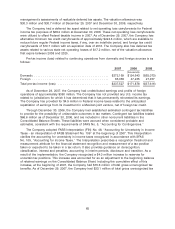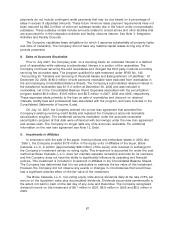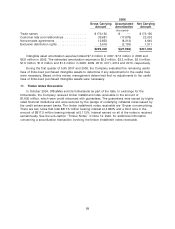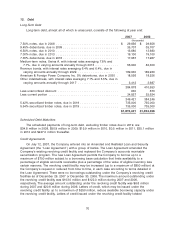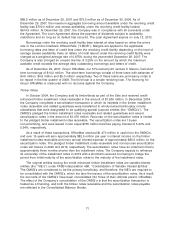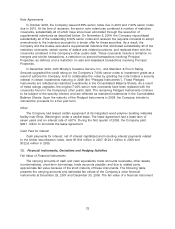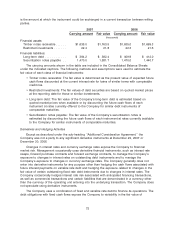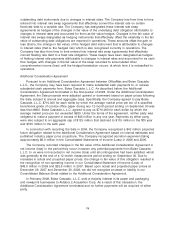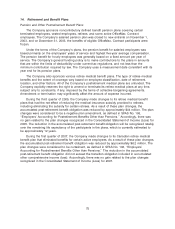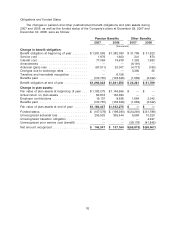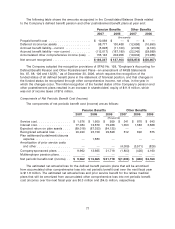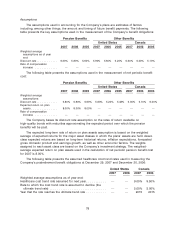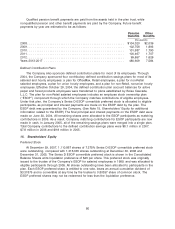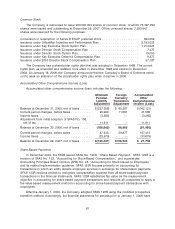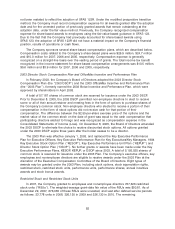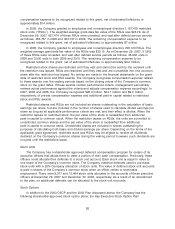OfficeMax 2007 Annual Report Download - page 77
Download and view the complete annual report
Please find page 77 of the 2007 OfficeMax annual report below. You can navigate through the pages in the report by either clicking on the pages listed below, or by using the keyword search tool below to find specific information within the annual report.
is the amount at which the instrument could be exchanged in a current transaction between willing
parties.
2007 2006
Carrying amount Fair value Carrying amount Fair value
(thousands)
Financial assets:
Timber notes receivable ...... $1,635.0 $1,763.5 $1,635.0 $1,669.3
Restricted investments ....... 22.4 21.8 22.3 21.6
Financial liabilities:
Long-term debt ............ $ 384.2 $ 382.4 $ 409.9 $ 412.0
Securitization notes payable . . 1,470.0 1,581.7 1,470.0 1,440.7
The carrying amounts shown in the table are included in the Consolidated Balance Sheets
under the indicated captions. The following methods and assumptions were used to estimate the
fair value of each class of financial instruments:
• Timber notes receivable: The fair value is determined as the present value of expected future
cash flows discounted at the current interest rate for loans of similar terms with comparable
credit risk.
• Restricted investments: The fair values of debt securities are based on quoted market prices
at the reporting date for those or similar investments.
• Long-term debt: The fair value of the Company’s long-term debt is estimated based on
quoted market prices when available or by discounting the future cash flows of each
instrument at rates currently offered to the Company for similar debt instruments of
comparable maturities.
• Securitization notes payable: The fair value of the Company’s securitization notes is
estimated by discounting the future cash flows of each instrument at rates currently available
to the Company for similar instruments of comparable maturities.
Derivatives and Hedging Activities
Except as described under the sub-heading ‘‘Additional Consideration Agreement,’’ the
Company was not a party to any significant derivative instruments at December 29, 2007 or
December 30, 2006.
Changes in interest rates and currency exchange rates expose the Company to financial
market risk. Management occasionally uses derivative financial instruments, such as interest rate
swaps, forward purchase contracts and forward exchange contracts, to manage the Company’s
exposure to changes in interest rates on outstanding debt instruments and to manage the
Company’s exposure to changes in currency exchange rates. The Company generally does not
enter into derivative instruments for any purpose other than hedging the cash flows associated with
future interest payments on variable rate debt and hedging the exposure related to changes in the
fair value of certain outstanding fixed rate debt instruments due to changes in interest rates. The
Company occasionally hedges interest rate risk associated with anticipated financing transactions,
as well as commercial transactions and certain liabilities that are denominated in a currency other
than the currency of the operating unit entering into the underlying transaction. The Company does
not speculate using derivative instruments.
The Company uses a combination of fixed and variable rate debt to finance its operations. The
debt obligations with fixed cash flows expose the Company to variability in the fair value of
73




